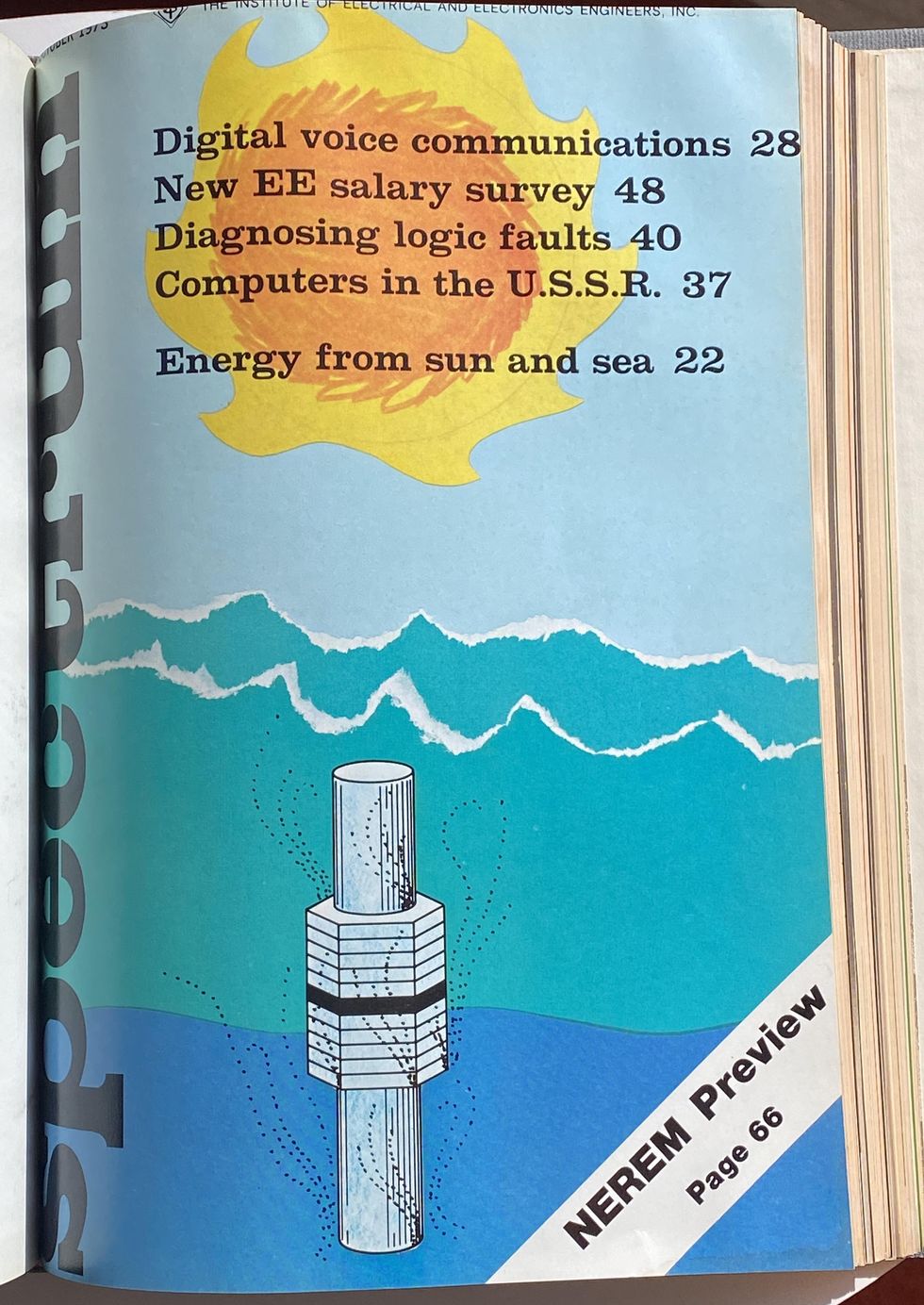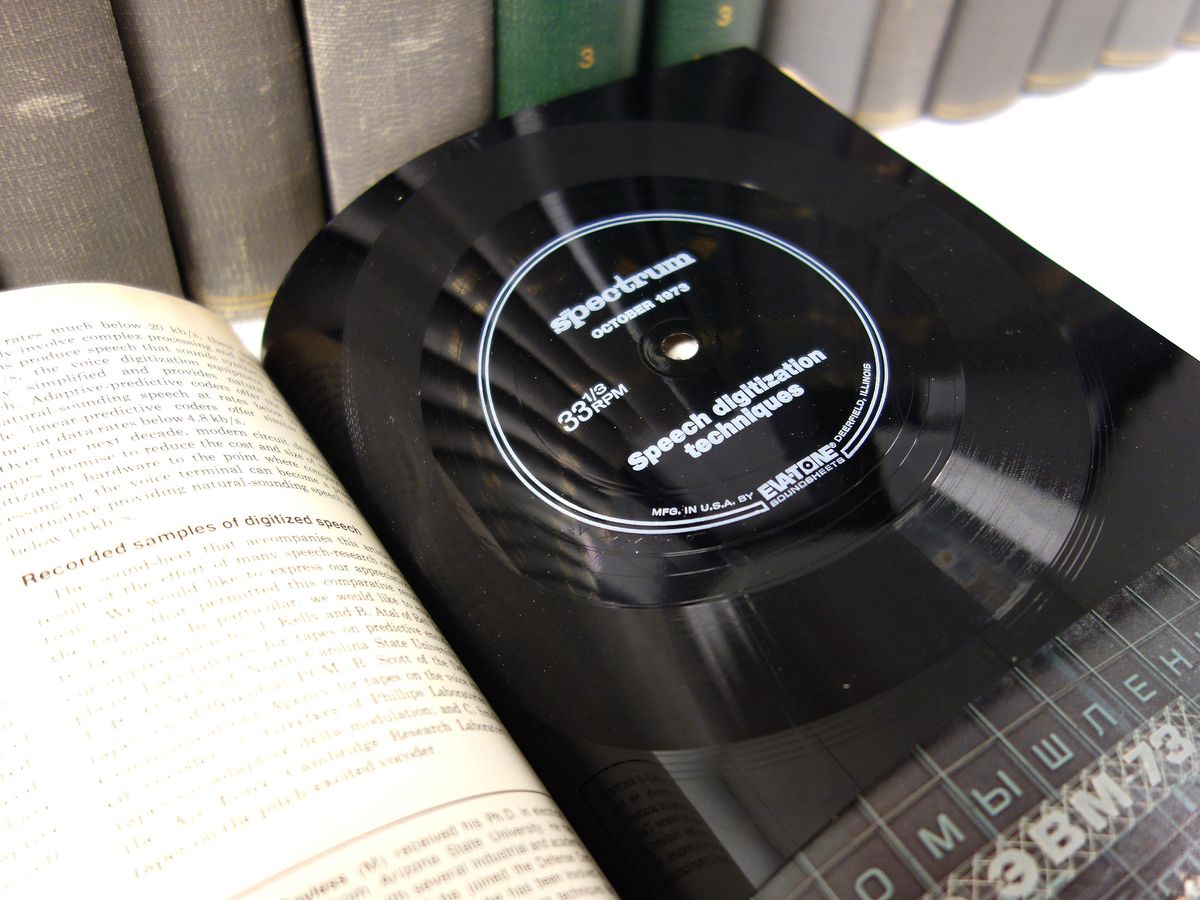“Ali Baba knew how men buy lime.”
“The beach is dry and shallow at low tide.”
“Few thieves are never sent to the judge.”
These cryptic sentences—and more than a dozen like them—were contained in the October 1973 issue of IEEE Spectrum. But unless you happen to have a perfectly preserved physical copy, you would never know they existed. It is impossible for any other reader to locate them, even using the IEEE Xplore digital library. The reason for their ongoing absence is that they never actually appeared in print. Instead, they were encoded in the grooves of a phonograph record bound inside the magazine. And there they would have stayed without a chance conversation and assistance from some very capable librarians and archivists.
A slim square of vinyl, measuring 18 centimeters on a side, the record is what’s known as a flexi disc, a lightweight alternative to traditional records that became popular after World War II. The technology had many precursors, including German “gramophone postcards” and Soviet “bone music”—jazz or rock recordings pressed onto discarded X-ray film to avoid government censorship. In the United States, the Eva-Tone Company of Deerfield, Ill., became the leading manufacturer of vinyl “sound sheets” (their preferred trademark) by the mid-1960s and promoted their use in “mailing pieces, financial reports, product instruction, sales training, and packaging inserts.”
Due to their low cost, thin form factor, and pliability, flexi discs became the medium of choice for magazine publishers who wished to supplement articles with audio content. Recordings were not limited to musical performances. For example, the December 1969 issue of National Geographic was dedicated to the Apollo 11 lunar landing and contained a sonic retrospective of the space race (“Sounds of the Space Age”) narrated by Apollo 8 commander Frank Borman.
This flexi disc is, in effect, an audio time capsule preserving the state of speech-digitization research in the early 1970s.
Nearly four years later, the flexi disc made its first (and last) appearance in Spectrum, accompanying an article entitled “Voice signals: bit-by-bit,” written by Jon W. Bayless, S. Joseph Campanella, and A.J. Goldberg. The piece provided an overview of the emerging field of voice digitization, which the authors suggested might alleviate the stress placed on global telecommunications networks by increased demand for long-distance and overseas phone calls. It was a prescient prediction, given that analog telephones are close to becoming extinct today.
The authors outlined two general strategies to convert human speech into a digital signal: voice-waveform digitization methods and vocoder methods. The first set of techniques, including pulse code modulation (PCM) and its variants, sampled the amplitude of an analog speech waveform at uniform intervals to generate a digital signal, which could be reconstructed in a receiver. Another approach revolved around the use of vocoders, devices that identified common speech patterns—such as voiced and unvoiced sounds—in an audio sample. Digital signals corresponding to those speech features were transmitted and used to assemble a new waveform that closely resembled the original.
Most of the article is devoted to technical descriptions of these competing methods, but the authors realized that a written summary could not fully convey the experience of listening to digitized voices. As a result, they collaborated with colleagues at academic, military, and industrial laboratories to record samples of various speech-digitization techniques. The recording lasts just under 6 minutes and contains 14 audio excerpts, each consisting of a few sentences that were generated using different methods and sampling rates. The resulting passages are frequently nonsensical, but the words themselves are less important than any noise or distortion resulting from the digitization process.
This flexi disc is, in effect, an audio time capsule preserving the state of speech digitization research in the early 1970s. (It is telling, for example, that women’s voices are not represented in any of the sound samples.) Yet despite its historical significance, its contents remained buried within the pages of a half-century-old Spectrum back issue until this spring, when Special Projects Editor Stephen Cass brought it to my attention following a meeting of the magazine’s editorial advisory board. He had found the record in a bound set of back issues kept in the Spectrum offices and was eager to digitize its contents. Before attempting to extract it from the magazine, however, he wanted to ensure there was at least one other copy that could serve as a backup—even within Spectrum’s archives, other, unbound, copies of the October 1973 issue were missing the flexi disc.
Cass approached me with this question because I work at the Linda Hall Library (LHL), an independent research library in Kansas City, Miss., that collects materials related to science, technology, engineering, and their histories. Since 1995, LHL has been the home of the 360,000 volumes formerly housed at the Engineering Societies Library, including extended runs of most IEEE journals. Moreover, unlike some libraries, which have downsized their journal collections in favor of electronic databases, LHL remains committed to preserving its print holdings. It therefore seemed extremely likely that a copy of the flexi disc could be found in our stacks.

At least, that was what I thought when I logged into our online catalog and requested the July-December 1973 volume of IEEE Spectrum. After waiting a few minutes for our page staff to locate the journal in the stacks, I called the main reference desk and asked the librarian on duty, Jamie Cumby, to locate the record between pages 34 and 37 in the October issue. One can only imagine my disappointment when she reported its absence.
What could have happened to the disc? Perhaps it had been set aside by an overzealous librarian before being shipped to the bindery. Or maybe an unscrupulous engineer had absconded with the disc after the issue arrived in Kansas City. In any case, I started wondering if there might be another copy of the magazine in our stacks and, if so, where it might be located. I probably would have kept speculating along these lines if Cumby had not continued inspecting the journal volume in her hands. A few moments later, she discovered the record nestled in an archival sleeve mounted on the inside back cover by a thoughtful bookbinder. This news, relayed via speakerphone, prompted cheers from the editors and other members of the advisory board huddled around the phone. Having located another copy of the flexi disc, one that had already been extracted from its binding, the only remaining question was how to access its contents.
This flexi disc is also a reminder of the ongoing value of libraries and archives to 21st-century researchers.
So far as I was aware, LHL did not own a functioning phonograph player, much less the equipment needed to make a high-quality recording. Fortunately, our building is located across the street from the Marr Sound Archives at the University of Missouri–Kansas City. The archive is home to approximately 400,000 recordings in every conceivable format, from wax cylinders to open-reel tapes. Surely, its staff would know how to handle a flexi disc!
Following my return to the Midwest, I reached out to Derek Long, the Marr Archives’ director, who confirmed that it would be relatively straightforward to digitize the disc. I dropped it off with him on a Wednesday morning and both .WAV and .MP3 versions of the recording were available before the end of the week. Long was also kind enough to capture the entire digitization process on video.
Digital Audio Rescued From Analog Diskyoutu.be
There is something elegantly recursive about watching this flexi disc revolve on the turntable and hearing the resulting stream of sample sentences. After all, this is a digital video of an analog record that contains samples of digitized human speech. Variations of the PCM and vocoder techniques that are demonstrated here are still used to encode audio signals today.
Beyond its significance as an artifact of the early days of digital audio, this flexi disc is also a reminder of the ongoing value of libraries and archives to 21st-century researchers. Databases like IEEE Xplore allow users to review a vast amount of scientific and technical literature, but they are not comprehensive. There are still plenty of books and journals that have never been scanned, not to mention multimedia materials that might be more complicated to digitize or distribute. Whether one considers audio recordings or scarcely held publications, sometimes there is just no substitute for consulting the original source.
- QuickTime's Developers Reflect on Doing Digital Video in Software ... ›
- A Digital Piano With Good Vibrations - IEEE Spectrum ›
- Digital Audio's Final Frontier - IEEE Spectrum ›
Benjamin Gross is a research fellow at the Chemical Heritage Foundation in Philadelphia. His Ph.D. dissertation at Princeton University looked at the development of the first liquid crystal displays at RCA.



